Public Health Program For Obesity Management
VerifiedAdded on 2022/09/09
|9
|2383
|30
AI Summary
Contribute Materials
Your contribution can guide someone’s learning journey. Share your
documents today.
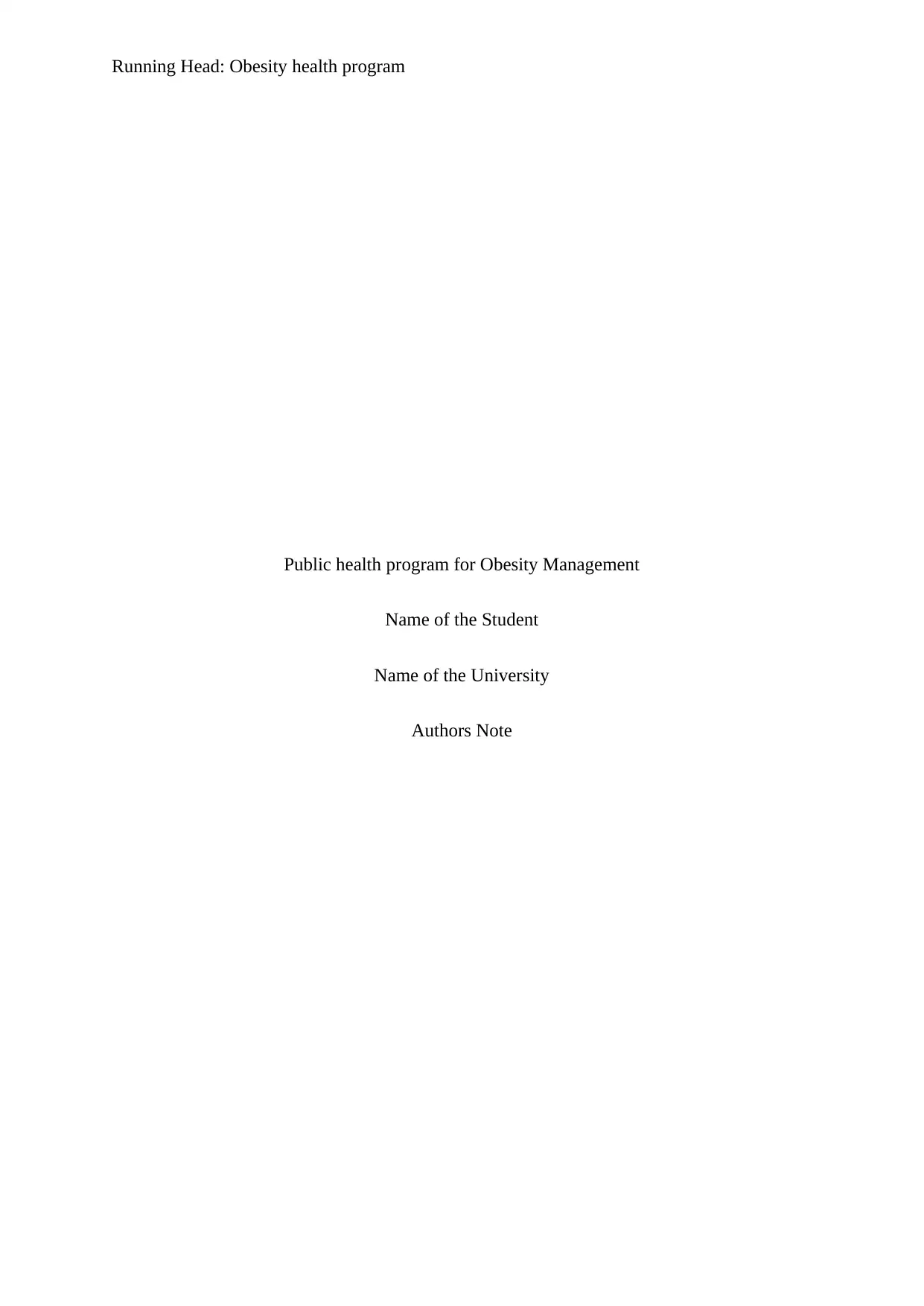
Running Head: Obesity health program
Public health program for Obesity Management
Name of the Student
Name of the University
Authors Note
Public health program for Obesity Management
Name of the Student
Name of the University
Authors Note
Secure Best Marks with AI Grader
Need help grading? Try our AI Grader for instant feedback on your assignments.
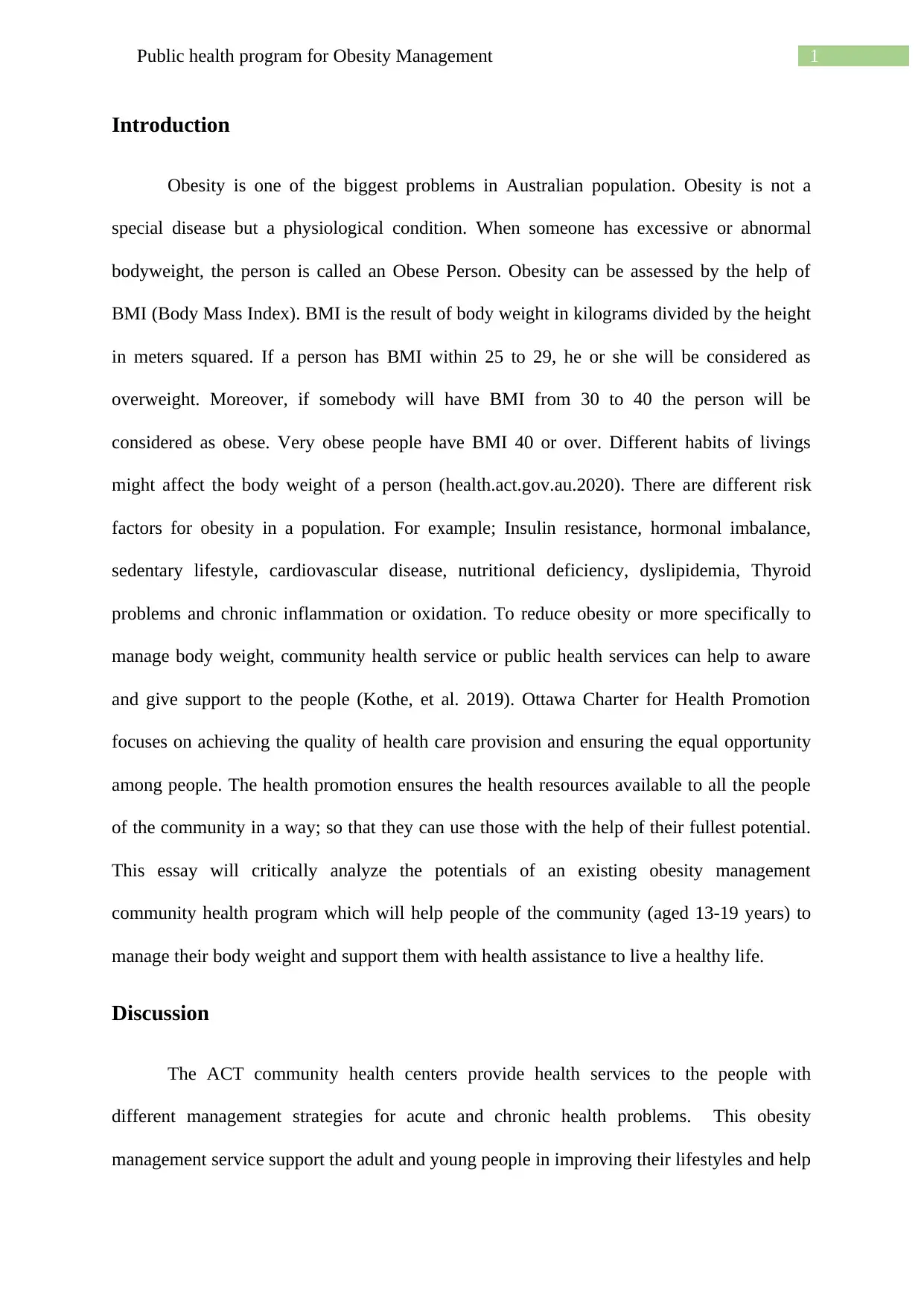
1Public health program for Obesity Management
Introduction
Obesity is one of the biggest problems in Australian population. Obesity is not a
special disease but a physiological condition. When someone has excessive or abnormal
bodyweight, the person is called an Obese Person. Obesity can be assessed by the help of
BMI (Body Mass Index). BMI is the result of body weight in kilograms divided by the height
in meters squared. If a person has BMI within 25 to 29, he or she will be considered as
overweight. Moreover, if somebody will have BMI from 30 to 40 the person will be
considered as obese. Very obese people have BMI 40 or over. Different habits of livings
might affect the body weight of a person (health.act.gov.au.2020). There are different risk
factors for obesity in a population. For example; Insulin resistance, hormonal imbalance,
sedentary lifestyle, cardiovascular disease, nutritional deficiency, dyslipidemia, Thyroid
problems and chronic inflammation or oxidation. To reduce obesity or more specifically to
manage body weight, community health service or public health services can help to aware
and give support to the people (Kothe, et al. 2019). Ottawa Charter for Health Promotion
focuses on achieving the quality of health care provision and ensuring the equal opportunity
among people. The health promotion ensures the health resources available to all the people
of the community in a way; so that they can use those with the help of their fullest potential.
This essay will critically analyze the potentials of an existing obesity management
community health program which will help people of the community (aged 13-19 years) to
manage their body weight and support them with health assistance to live a healthy life.
Discussion
The ACT community health centers provide health services to the people with
different management strategies for acute and chronic health problems. This obesity
management service support the adult and young people in improving their lifestyles and help
Introduction
Obesity is one of the biggest problems in Australian population. Obesity is not a
special disease but a physiological condition. When someone has excessive or abnormal
bodyweight, the person is called an Obese Person. Obesity can be assessed by the help of
BMI (Body Mass Index). BMI is the result of body weight in kilograms divided by the height
in meters squared. If a person has BMI within 25 to 29, he or she will be considered as
overweight. Moreover, if somebody will have BMI from 30 to 40 the person will be
considered as obese. Very obese people have BMI 40 or over. Different habits of livings
might affect the body weight of a person (health.act.gov.au.2020). There are different risk
factors for obesity in a population. For example; Insulin resistance, hormonal imbalance,
sedentary lifestyle, cardiovascular disease, nutritional deficiency, dyslipidemia, Thyroid
problems and chronic inflammation or oxidation. To reduce obesity or more specifically to
manage body weight, community health service or public health services can help to aware
and give support to the people (Kothe, et al. 2019). Ottawa Charter for Health Promotion
focuses on achieving the quality of health care provision and ensuring the equal opportunity
among people. The health promotion ensures the health resources available to all the people
of the community in a way; so that they can use those with the help of their fullest potential.
This essay will critically analyze the potentials of an existing obesity management
community health program which will help people of the community (aged 13-19 years) to
manage their body weight and support them with health assistance to live a healthy life.
Discussion
The ACT community health centers provide health services to the people with
different management strategies for acute and chronic health problems. This obesity
management service support the adult and young people in improving their lifestyles and help
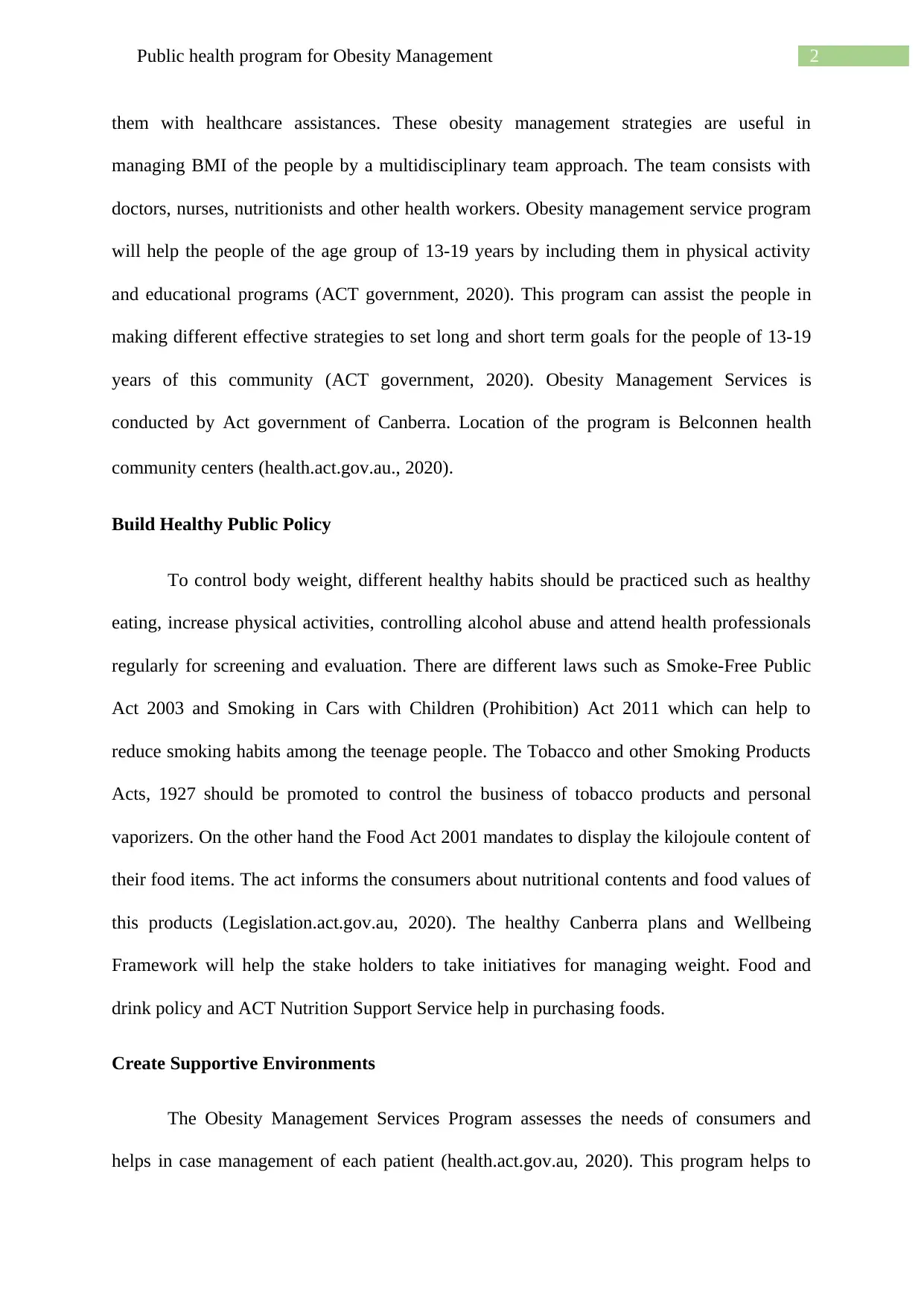
2Public health program for Obesity Management
them with healthcare assistances. These obesity management strategies are useful in
managing BMI of the people by a multidisciplinary team approach. The team consists with
doctors, nurses, nutritionists and other health workers. Obesity management service program
will help the people of the age group of 13-19 years by including them in physical activity
and educational programs (ACT government, 2020). This program can assist the people in
making different effective strategies to set long and short term goals for the people of 13-19
years of this community (ACT government, 2020). Obesity Management Services is
conducted by Act government of Canberra. Location of the program is Belconnen health
community centers (health.act.gov.au., 2020).
Build Healthy Public Policy
To control body weight, different healthy habits should be practiced such as healthy
eating, increase physical activities, controlling alcohol abuse and attend health professionals
regularly for screening and evaluation. There are different laws such as Smoke-Free Public
Act 2003 and Smoking in Cars with Children (Prohibition) Act 2011 which can help to
reduce smoking habits among the teenage people. The Tobacco and other Smoking Products
Acts, 1927 should be promoted to control the business of tobacco products and personal
vaporizers. On the other hand the Food Act 2001 mandates to display the kilojoule content of
their food items. The act informs the consumers about nutritional contents and food values of
this products (Legislation.act.gov.au, 2020). The healthy Canberra plans and Wellbeing
Framework will help the stake holders to take initiatives for managing weight. Food and
drink policy and ACT Nutrition Support Service help in purchasing foods.
Create Supportive Environments
The Obesity Management Services Program assesses the needs of consumers and
helps in case management of each patient (health.act.gov.au, 2020). This program helps to
them with healthcare assistances. These obesity management strategies are useful in
managing BMI of the people by a multidisciplinary team approach. The team consists with
doctors, nurses, nutritionists and other health workers. Obesity management service program
will help the people of the age group of 13-19 years by including them in physical activity
and educational programs (ACT government, 2020). This program can assist the people in
making different effective strategies to set long and short term goals for the people of 13-19
years of this community (ACT government, 2020). Obesity Management Services is
conducted by Act government of Canberra. Location of the program is Belconnen health
community centers (health.act.gov.au., 2020).
Build Healthy Public Policy
To control body weight, different healthy habits should be practiced such as healthy
eating, increase physical activities, controlling alcohol abuse and attend health professionals
regularly for screening and evaluation. There are different laws such as Smoke-Free Public
Act 2003 and Smoking in Cars with Children (Prohibition) Act 2011 which can help to
reduce smoking habits among the teenage people. The Tobacco and other Smoking Products
Acts, 1927 should be promoted to control the business of tobacco products and personal
vaporizers. On the other hand the Food Act 2001 mandates to display the kilojoule content of
their food items. The act informs the consumers about nutritional contents and food values of
this products (Legislation.act.gov.au, 2020). The healthy Canberra plans and Wellbeing
Framework will help the stake holders to take initiatives for managing weight. Food and
drink policy and ACT Nutrition Support Service help in purchasing foods.
Create Supportive Environments
The Obesity Management Services Program assesses the needs of consumers and
helps in case management of each patient (health.act.gov.au, 2020). This program helps to

3Public health program for Obesity Management
build better knowledge about nutrition and food consumption. Different multidisciplinary
professionals are associated with this health program. For example; doctors for prescribing
and suggesting the medications, nurses to support 13-19 years aged patients and community
people to maintain good health. Referral services help the doctors to refer their client by the
help of Community Health Initiative of ACT health electronic referral system. There are
different initiatives proposed by ACT Government to promote better health and wellbeing in
the communities of Canberra. Physical activity programs are promoted by the government to
reduce the risk factors related to physical inactivity among different group of people.
Additionally the long-term care management will also be promoted in this healthcare
program. According to chief health officer’s report 2018, Canberra ACT government helps in
building the tobacco free zones to provide clean air for the citizens. ACT government has
proposed different policies which help the community people (especially 13-19 years) to
consume healthy foods. National Healthy School Canteen guidelines will help the young
people of 13- 19 years age group to maintain good food habits (Andela, et al. 2019).
Additionally, Australian Dietary Guidelines helps the people of Canberra in choosing
nutrition rich meals. Unhealthy food and drinks are the causes of weight gain among the
children and adults. Therefore Kilojoule Display Laws will help the consumers to choose
healthy food items. By implementing the Food Act, Canberra government help people to eat
healthy foods. The food act suggests that all the restaurants and cafeterias will be monitored
by the government (Harris et al. 2017). According to ACT preventive Health plan 2020-2025,
healthy foods and food habits will be promoted in schools, workplaces, recreational venues
by advertisement and media promotions.
Strengthen Community Actions
Australian physical activity and sedentary behaviors guidelines suggests that every
person should exercise for at least two days of a week. People should practice moderate
build better knowledge about nutrition and food consumption. Different multidisciplinary
professionals are associated with this health program. For example; doctors for prescribing
and suggesting the medications, nurses to support 13-19 years aged patients and community
people to maintain good health. Referral services help the doctors to refer their client by the
help of Community Health Initiative of ACT health electronic referral system. There are
different initiatives proposed by ACT Government to promote better health and wellbeing in
the communities of Canberra. Physical activity programs are promoted by the government to
reduce the risk factors related to physical inactivity among different group of people.
Additionally the long-term care management will also be promoted in this healthcare
program. According to chief health officer’s report 2018, Canberra ACT government helps in
building the tobacco free zones to provide clean air for the citizens. ACT government has
proposed different policies which help the community people (especially 13-19 years) to
consume healthy foods. National Healthy School Canteen guidelines will help the young
people of 13- 19 years age group to maintain good food habits (Andela, et al. 2019).
Additionally, Australian Dietary Guidelines helps the people of Canberra in choosing
nutrition rich meals. Unhealthy food and drinks are the causes of weight gain among the
children and adults. Therefore Kilojoule Display Laws will help the consumers to choose
healthy food items. By implementing the Food Act, Canberra government help people to eat
healthy foods. The food act suggests that all the restaurants and cafeterias will be monitored
by the government (Harris et al. 2017). According to ACT preventive Health plan 2020-2025,
healthy foods and food habits will be promoted in schools, workplaces, recreational venues
by advertisement and media promotions.
Strengthen Community Actions
Australian physical activity and sedentary behaviors guidelines suggests that every
person should exercise for at least two days of a week. People should practice moderate
Secure Best Marks with AI Grader
Need help grading? Try our AI Grader for instant feedback on your assignments.
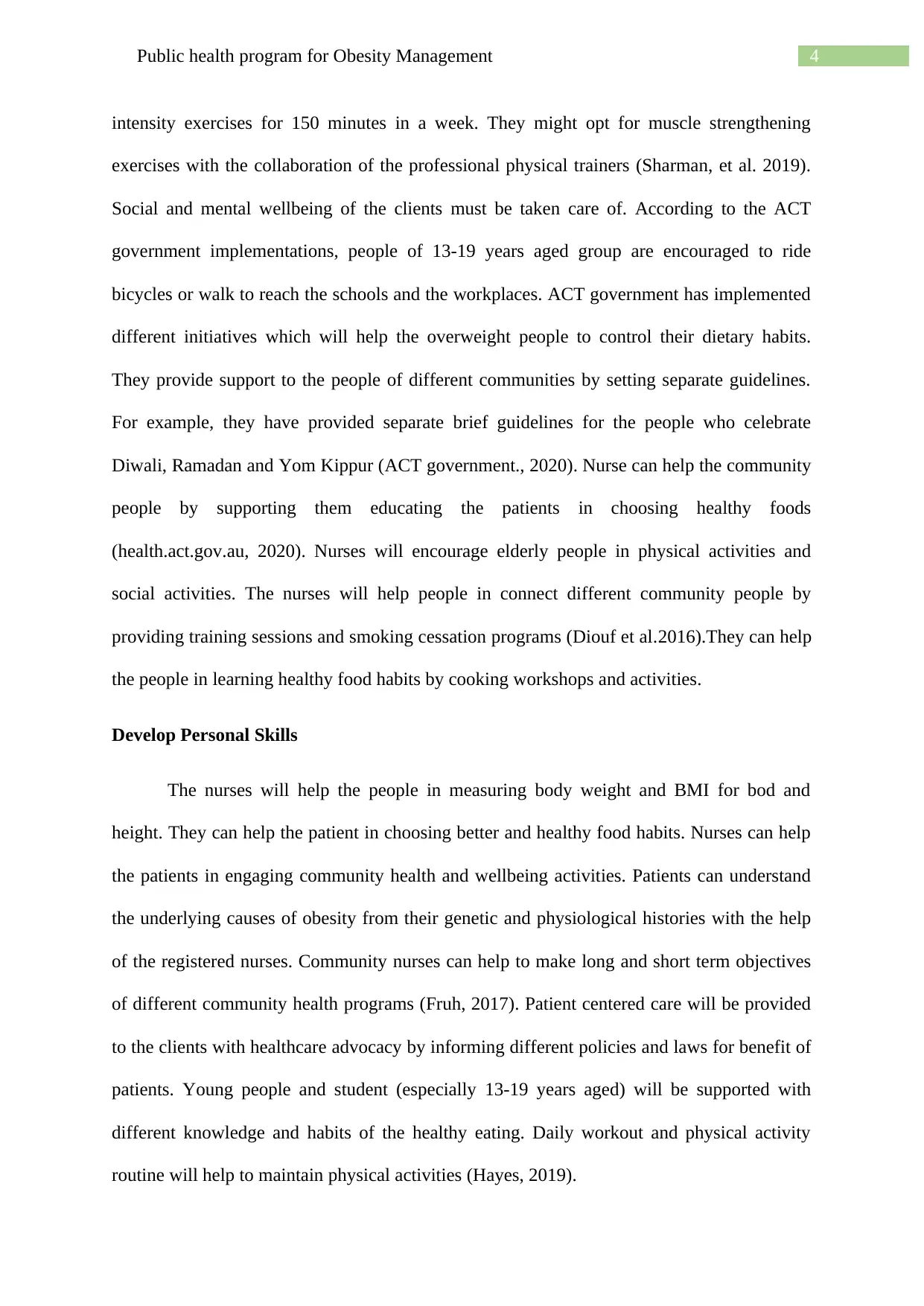
4Public health program for Obesity Management
intensity exercises for 150 minutes in a week. They might opt for muscle strengthening
exercises with the collaboration of the professional physical trainers (Sharman, et al. 2019).
Social and mental wellbeing of the clients must be taken care of. According to the ACT
government implementations, people of 13-19 years aged group are encouraged to ride
bicycles or walk to reach the schools and the workplaces. ACT government has implemented
different initiatives which will help the overweight people to control their dietary habits.
They provide support to the people of different communities by setting separate guidelines.
For example, they have provided separate brief guidelines for the people who celebrate
Diwali, Ramadan and Yom Kippur (ACT government., 2020). Nurse can help the community
people by supporting them educating the patients in choosing healthy foods
(health.act.gov.au, 2020). Nurses will encourage elderly people in physical activities and
social activities. The nurses will help people in connect different community people by
providing training sessions and smoking cessation programs (Diouf et al.2016).They can help
the people in learning healthy food habits by cooking workshops and activities.
Develop Personal Skills
The nurses will help the people in measuring body weight and BMI for bod and
height. They can help the patient in choosing better and healthy food habits. Nurses can help
the patients in engaging community health and wellbeing activities. Patients can understand
the underlying causes of obesity from their genetic and physiological histories with the help
of the registered nurses. Community nurses can help to make long and short term objectives
of different community health programs (Fruh, 2017). Patient centered care will be provided
to the clients with healthcare advocacy by informing different policies and laws for benefit of
patients. Young people and student (especially 13-19 years aged) will be supported with
different knowledge and habits of the healthy eating. Daily workout and physical activity
routine will help to maintain physical activities (Hayes, 2019).
intensity exercises for 150 minutes in a week. They might opt for muscle strengthening
exercises with the collaboration of the professional physical trainers (Sharman, et al. 2019).
Social and mental wellbeing of the clients must be taken care of. According to the ACT
government implementations, people of 13-19 years aged group are encouraged to ride
bicycles or walk to reach the schools and the workplaces. ACT government has implemented
different initiatives which will help the overweight people to control their dietary habits.
They provide support to the people of different communities by setting separate guidelines.
For example, they have provided separate brief guidelines for the people who celebrate
Diwali, Ramadan and Yom Kippur (ACT government., 2020). Nurse can help the community
people by supporting them educating the patients in choosing healthy foods
(health.act.gov.au, 2020). Nurses will encourage elderly people in physical activities and
social activities. The nurses will help people in connect different community people by
providing training sessions and smoking cessation programs (Diouf et al.2016).They can help
the people in learning healthy food habits by cooking workshops and activities.
Develop Personal Skills
The nurses will help the people in measuring body weight and BMI for bod and
height. They can help the patient in choosing better and healthy food habits. Nurses can help
the patients in engaging community health and wellbeing activities. Patients can understand
the underlying causes of obesity from their genetic and physiological histories with the help
of the registered nurses. Community nurses can help to make long and short term objectives
of different community health programs (Fruh, 2017). Patient centered care will be provided
to the clients with healthcare advocacy by informing different policies and laws for benefit of
patients. Young people and student (especially 13-19 years aged) will be supported with
different knowledge and habits of the healthy eating. Daily workout and physical activity
routine will help to maintain physical activities (Hayes, 2019).
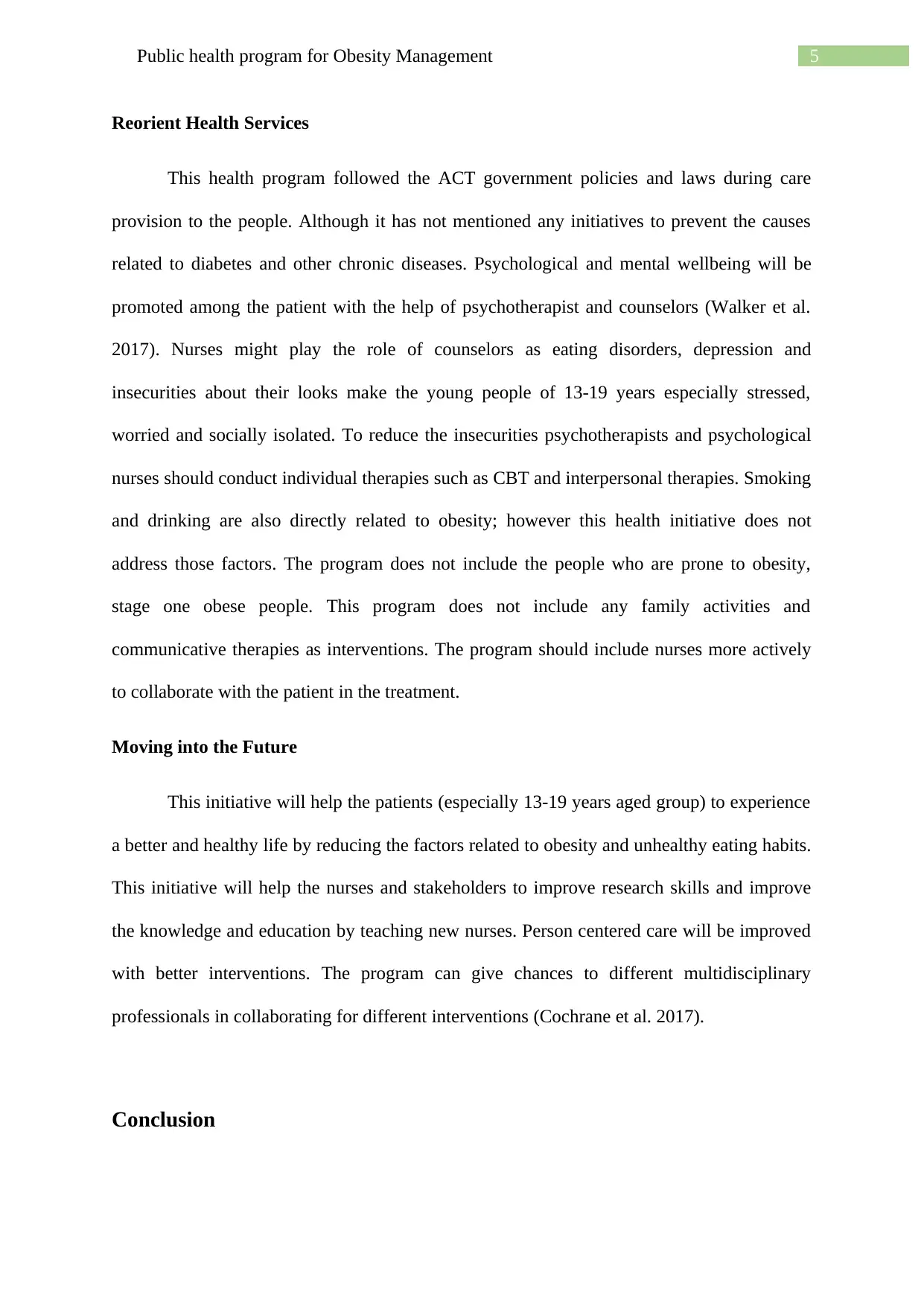
5Public health program for Obesity Management
Reorient Health Services
This health program followed the ACT government policies and laws during care
provision to the people. Although it has not mentioned any initiatives to prevent the causes
related to diabetes and other chronic diseases. Psychological and mental wellbeing will be
promoted among the patient with the help of psychotherapist and counselors (Walker et al.
2017). Nurses might play the role of counselors as eating disorders, depression and
insecurities about their looks make the young people of 13-19 years especially stressed,
worried and socially isolated. To reduce the insecurities psychotherapists and psychological
nurses should conduct individual therapies such as CBT and interpersonal therapies. Smoking
and drinking are also directly related to obesity; however this health initiative does not
address those factors. The program does not include the people who are prone to obesity,
stage one obese people. This program does not include any family activities and
communicative therapies as interventions. The program should include nurses more actively
to collaborate with the patient in the treatment.
Moving into the Future
This initiative will help the patients (especially 13-19 years aged group) to experience
a better and healthy life by reducing the factors related to obesity and unhealthy eating habits.
This initiative will help the nurses and stakeholders to improve research skills and improve
the knowledge and education by teaching new nurses. Person centered care will be improved
with better interventions. The program can give chances to different multidisciplinary
professionals in collaborating for different interventions (Cochrane et al. 2017).
Conclusion
Reorient Health Services
This health program followed the ACT government policies and laws during care
provision to the people. Although it has not mentioned any initiatives to prevent the causes
related to diabetes and other chronic diseases. Psychological and mental wellbeing will be
promoted among the patient with the help of psychotherapist and counselors (Walker et al.
2017). Nurses might play the role of counselors as eating disorders, depression and
insecurities about their looks make the young people of 13-19 years especially stressed,
worried and socially isolated. To reduce the insecurities psychotherapists and psychological
nurses should conduct individual therapies such as CBT and interpersonal therapies. Smoking
and drinking are also directly related to obesity; however this health initiative does not
address those factors. The program does not include the people who are prone to obesity,
stage one obese people. This program does not include any family activities and
communicative therapies as interventions. The program should include nurses more actively
to collaborate with the patient in the treatment.
Moving into the Future
This initiative will help the patients (especially 13-19 years aged group) to experience
a better and healthy life by reducing the factors related to obesity and unhealthy eating habits.
This initiative will help the nurses and stakeholders to improve research skills and improve
the knowledge and education by teaching new nurses. Person centered care will be improved
with better interventions. The program can give chances to different multidisciplinary
professionals in collaborating for different interventions (Cochrane et al. 2017).
Conclusion

6Public health program for Obesity Management
This essay can conclude that the Obesity Management Service program will help the
people with obesity to control overeating and unhealthy food habits. This program will help
the people of 13-19 years to practice healthy habits and promote different rules and
guidelines among the population of Canberra. Referral programs and multidisciplinary
approach increase the effectiveness of this program in reducing obesity. There are some
limitations, present in the service which should be overcome by the stakeholders of this
service. After overcoming, the limitations this program will give different opportunities to
patients and the health care professionals to obtain the optimum health facilities.
This essay can conclude that the Obesity Management Service program will help the
people with obesity to control overeating and unhealthy food habits. This program will help
the people of 13-19 years to practice healthy habits and promote different rules and
guidelines among the population of Canberra. Referral programs and multidisciplinary
approach increase the effectiveness of this program in reducing obesity. There are some
limitations, present in the service which should be overcome by the stakeholders of this
service. After overcoming, the limitations this program will give different opportunities to
patients and the health care professionals to obtain the optimum health facilities.
Paraphrase This Document
Need a fresh take? Get an instant paraphrase of this document with our AI Paraphraser
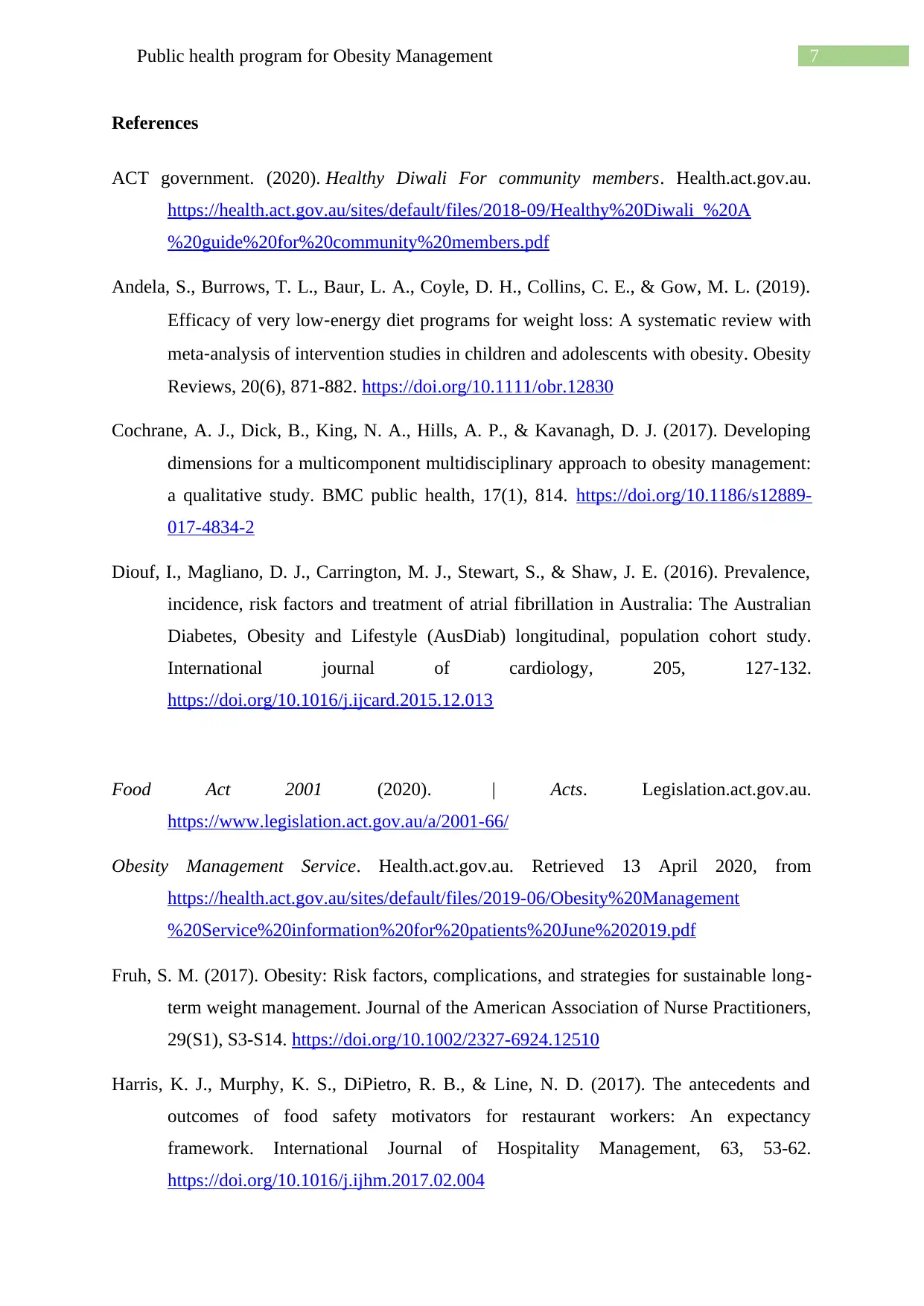
7Public health program for Obesity Management
References
ACT government. (2020). Healthy Diwali For community members. Health.act.gov.au.
https://health.act.gov.au/sites/default/files/2018-09/Healthy%20Diwali_%20A
%20guide%20for%20community%20members.pdf
Andela, S., Burrows, T. L., Baur, L. A., Coyle, D. H., Collins, C. E., & Gow, M. L. (2019).
Efficacy of very low‐energy diet programs for weight loss: A systematic review with
meta‐analysis of intervention studies in children and adolescents with obesity. Obesity
Reviews, 20(6), 871-882. https://doi.org/10.1111/obr.12830
Cochrane, A. J., Dick, B., King, N. A., Hills, A. P., & Kavanagh, D. J. (2017). Developing
dimensions for a multicomponent multidisciplinary approach to obesity management:
a qualitative study. BMC public health, 17(1), 814. https://doi.org/10.1186/s12889-
017-4834-2
Diouf, I., Magliano, D. J., Carrington, M. J., Stewart, S., & Shaw, J. E. (2016). Prevalence,
incidence, risk factors and treatment of atrial fibrillation in Australia: The Australian
Diabetes, Obesity and Lifestyle (AusDiab) longitudinal, population cohort study.
International journal of cardiology, 205, 127-132.
https://doi.org/10.1016/j.ijcard.2015.12.013
Food Act 2001 (2020). | Acts. Legislation.act.gov.au.
https://www.legislation.act.gov.au/a/2001-66/
Obesity Management Service. Health.act.gov.au. Retrieved 13 April 2020, from
https://health.act.gov.au/sites/default/files/2019-06/Obesity%20Management
%20Service%20information%20for%20patients%20June%202019.pdf
Fruh, S. M. (2017). Obesity: Risk factors, complications, and strategies for sustainable long‐
term weight management. Journal of the American Association of Nurse Practitioners,
29(S1), S3-S14. https://doi.org/10.1002/2327-6924.12510
Harris, K. J., Murphy, K. S., DiPietro, R. B., & Line, N. D. (2017). The antecedents and
outcomes of food safety motivators for restaurant workers: An expectancy
framework. International Journal of Hospitality Management, 63, 53-62.
https://doi.org/10.1016/j.ijhm.2017.02.004
References
ACT government. (2020). Healthy Diwali For community members. Health.act.gov.au.
https://health.act.gov.au/sites/default/files/2018-09/Healthy%20Diwali_%20A
%20guide%20for%20community%20members.pdf
Andela, S., Burrows, T. L., Baur, L. A., Coyle, D. H., Collins, C. E., & Gow, M. L. (2019).
Efficacy of very low‐energy diet programs for weight loss: A systematic review with
meta‐analysis of intervention studies in children and adolescents with obesity. Obesity
Reviews, 20(6), 871-882. https://doi.org/10.1111/obr.12830
Cochrane, A. J., Dick, B., King, N. A., Hills, A. P., & Kavanagh, D. J. (2017). Developing
dimensions for a multicomponent multidisciplinary approach to obesity management:
a qualitative study. BMC public health, 17(1), 814. https://doi.org/10.1186/s12889-
017-4834-2
Diouf, I., Magliano, D. J., Carrington, M. J., Stewart, S., & Shaw, J. E. (2016). Prevalence,
incidence, risk factors and treatment of atrial fibrillation in Australia: The Australian
Diabetes, Obesity and Lifestyle (AusDiab) longitudinal, population cohort study.
International journal of cardiology, 205, 127-132.
https://doi.org/10.1016/j.ijcard.2015.12.013
Food Act 2001 (2020). | Acts. Legislation.act.gov.au.
https://www.legislation.act.gov.au/a/2001-66/
Obesity Management Service. Health.act.gov.au. Retrieved 13 April 2020, from
https://health.act.gov.au/sites/default/files/2019-06/Obesity%20Management
%20Service%20information%20for%20patients%20June%202019.pdf
Fruh, S. M. (2017). Obesity: Risk factors, complications, and strategies for sustainable long‐
term weight management. Journal of the American Association of Nurse Practitioners,
29(S1), S3-S14. https://doi.org/10.1002/2327-6924.12510
Harris, K. J., Murphy, K. S., DiPietro, R. B., & Line, N. D. (2017). The antecedents and
outcomes of food safety motivators for restaurant workers: An expectancy
framework. International Journal of Hospitality Management, 63, 53-62.
https://doi.org/10.1016/j.ijhm.2017.02.004
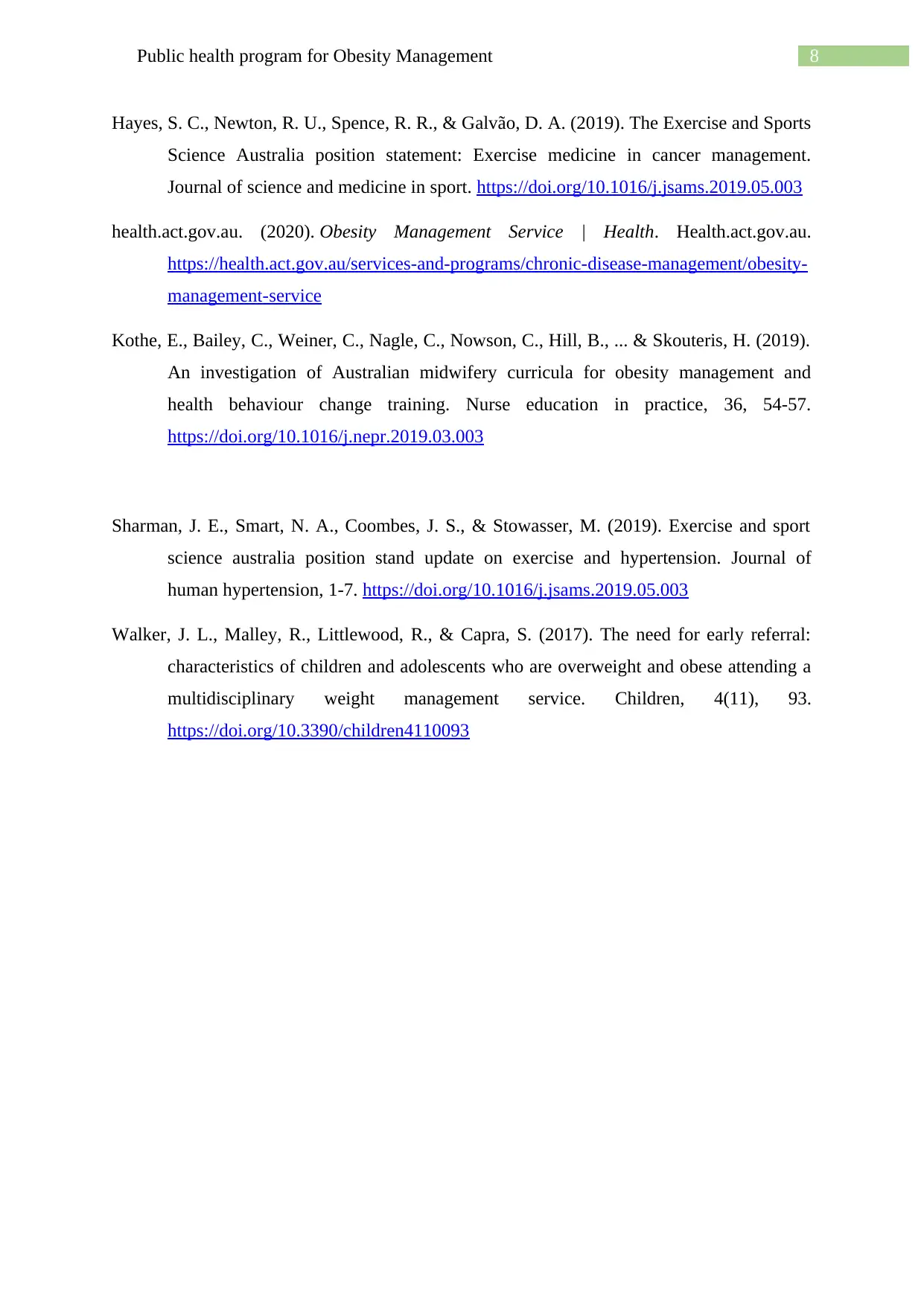
8Public health program for Obesity Management
Hayes, S. C., Newton, R. U., Spence, R. R., & Galvão, D. A. (2019). The Exercise and Sports
Science Australia position statement: Exercise medicine in cancer management.
Journal of science and medicine in sport. https://doi.org/10.1016/j.jsams.2019.05.003
health.act.gov.au. (2020). Obesity Management Service | Health. Health.act.gov.au.
https://health.act.gov.au/services-and-programs/chronic-disease-management/obesity-
management-service
Kothe, E., Bailey, C., Weiner, C., Nagle, C., Nowson, C., Hill, B., ... & Skouteris, H. (2019).
An investigation of Australian midwifery curricula for obesity management and
health behaviour change training. Nurse education in practice, 36, 54-57.
https://doi.org/10.1016/j.nepr.2019.03.003
Sharman, J. E., Smart, N. A., Coombes, J. S., & Stowasser, M. (2019). Exercise and sport
science australia position stand update on exercise and hypertension. Journal of
human hypertension, 1-7. https://doi.org/10.1016/j.jsams.2019.05.003
Walker, J. L., Malley, R., Littlewood, R., & Capra, S. (2017). The need for early referral:
characteristics of children and adolescents who are overweight and obese attending a
multidisciplinary weight management service. Children, 4(11), 93.
https://doi.org/10.3390/children4110093
Hayes, S. C., Newton, R. U., Spence, R. R., & Galvão, D. A. (2019). The Exercise and Sports
Science Australia position statement: Exercise medicine in cancer management.
Journal of science and medicine in sport. https://doi.org/10.1016/j.jsams.2019.05.003
health.act.gov.au. (2020). Obesity Management Service | Health. Health.act.gov.au.
https://health.act.gov.au/services-and-programs/chronic-disease-management/obesity-
management-service
Kothe, E., Bailey, C., Weiner, C., Nagle, C., Nowson, C., Hill, B., ... & Skouteris, H. (2019).
An investigation of Australian midwifery curricula for obesity management and
health behaviour change training. Nurse education in practice, 36, 54-57.
https://doi.org/10.1016/j.nepr.2019.03.003
Sharman, J. E., Smart, N. A., Coombes, J. S., & Stowasser, M. (2019). Exercise and sport
science australia position stand update on exercise and hypertension. Journal of
human hypertension, 1-7. https://doi.org/10.1016/j.jsams.2019.05.003
Walker, J. L., Malley, R., Littlewood, R., & Capra, S. (2017). The need for early referral:
characteristics of children and adolescents who are overweight and obese attending a
multidisciplinary weight management service. Children, 4(11), 93.
https://doi.org/10.3390/children4110093
1 out of 9
Related Documents
Your All-in-One AI-Powered Toolkit for Academic Success.
+13062052269
info@desklib.com
Available 24*7 on WhatsApp / Email
![[object Object]](/_next/static/media/star-bottom.7253800d.svg)
Unlock your academic potential
© 2024 | Zucol Services PVT LTD | All rights reserved.





